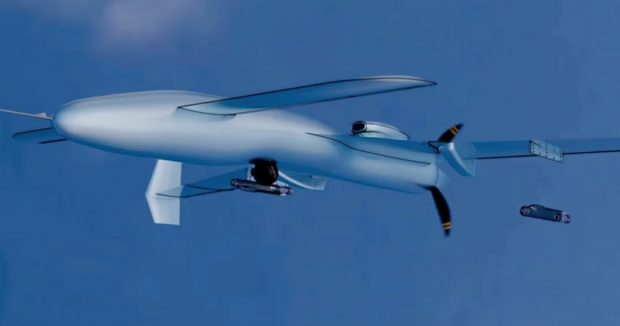The Piwdiennie Design Bureau (ukr. КБ Південне) presented the project of a duck-based attack drone, armed with precision ammunition. Both systems are currently being developed by a Kiev-based company with extensive experience in the field of missile weapons and space systems.
In the package of materials presenting the achievements of the Yuzhnoye State Design Office in 2021, a visualization of the unmanned aerial vehicle system and its armament were two laser guided missiles. Both systems are currently being developed by the design office. There is no information about the possible participation of the Ukrainian Ministry of Defense in financing these projects.
The unmanned aerial system is designed in a duck configuration with straight horizontal stabilizers and a wing with a variable slant ending with vertical stabilizers. The drive is to be a single engine with a pusher propeller located at the rear of the fuselage. The arrangement of the drive unit and air intake suggests that a turboprop engine may be considered. In the middle of the fuselage there is an optoelectronic head. Under the wings you can see two pylons under which soaring bombs were hung.
The precision ammunition designed by KB Piwdiennie was created not only for unmanned aerial vehicles but also for classic combat aircraft. In terms of layout and concept, it resembles the British MBDA Spear ammunition weighing about 100 kg. In the front part there is a guidance system with a wide-angle cover of the laser guidance system. Most likely, a system consisting of a head guiding the reflected laser beam and high-frequency radar was used, which ensures the possibility of guidance in all weather conditions, day and night.
The Ukrainian ammunition is equipped with simple, fold-out wings located near the center of gravity, and three fold-out fins in the rear part. It is not clear from the materials whether it is a soaring bomb or how the British Spear is powered by a turbojet engine. Some of the details in the animation suggest the latter option, especially the rapid acceleration of the projectile after detaching from the host and unfolding its wings.
The whole project looks coherent and considering the experience of KB Piwdiennie, it may have a good chance of being successful – if the source of financing is obtained. Currently, the Ukrainian industry is involved in the development of joint unmanned projects with Turkey, in particular the launch of the production of Bayraktar TB2 machines and cooperation in the construction of Akinci unmanned aerial vehicles. In both cases it is a cooperation with Baykar.
Last year, a model of the Sokił-300 unmanned aerial vehicle designed by the Łucz company was also presented.
Source: Defence 24

